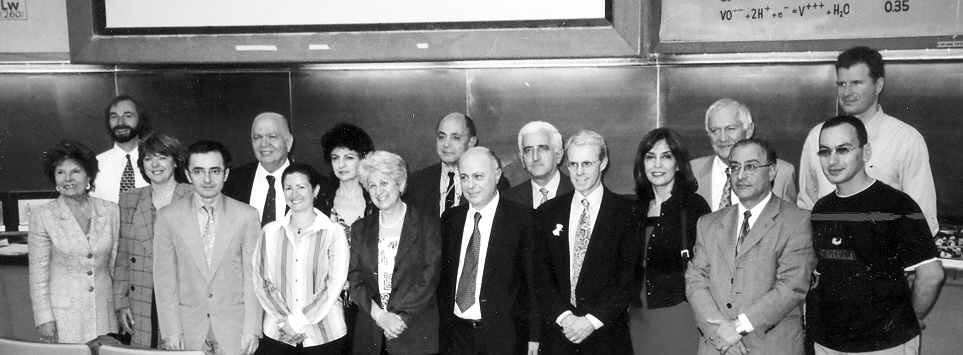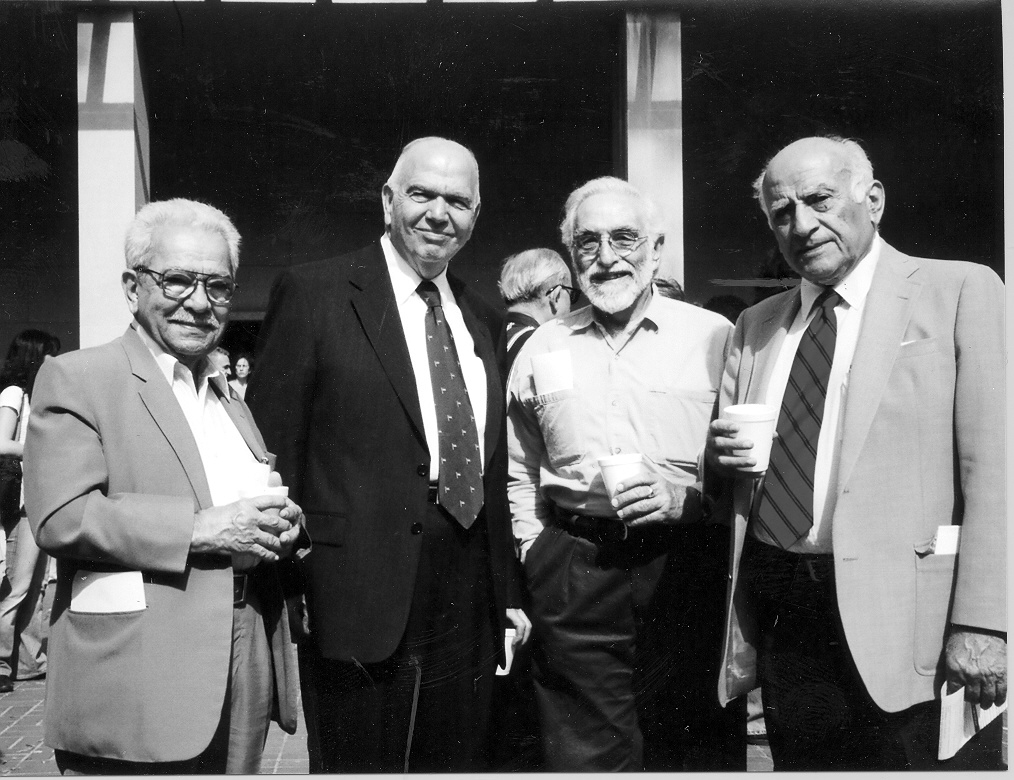 ( Not pictured : Gohar Avagyan, Anny Bakalian, RoseMary
Cohen )
( Not pictured : Gohar Avagyan, Anny Bakalian, RoseMary
Cohen )
( Claudia Der-Mardirosian, Onnik Hayrapetian )
|
- Group photo of participants: left
to right-- Rubina Peroomian, Peter Cowe, Elizabeth Redgate, Hovann
Simonian, Richard Hovannisian, Houri Beberbian, Gayane Hagopian, Gabriella
Uluhogian, Armen Hakhnazarian, Vazken Ghougassian, Armen Ter-Stepanyan,
Thomas Sinclair, Anahid Keshishian, Richard Elbrecht, Samvel Stepanian,
Bert Vaux, Artsvi Bakhchinyan.
|
- The fourteenth in the series of international conferences devoted
to historical Armenian cities and provinces, sponsored by the
Armenian Educational Foundation Chair in Modern Armenian history
at the University of California in Los Angeles, was held on May
14-16, 2004. This successful conference, organized by the holder of
the chair, Professor Richard Hovannisian, had a turnaround of more than
1,000 people and was devoted to the Armenian communities of Iran.
- The previous conference in this series, held last November, focused
entirely on the community of New Julfa in Iran on the occasion of the
400th anniversary of its founding. Now was the time to turn scholarly
attention to the other Armenian-Iranian communities. The conference
was co-sponsored by the Armenian Society of Los Angeles and the
UCLA
International Institute, G.
E. van Grunebaum Center for Near Eastern Studies, and Center
for European and Eurasian Studies.
Friday Evening Session in Armenian
- As in the previous conference, the opening session, on the evening
of May 14, was held in the sanctuary of the Presbyterian
Church in Glendale, home to a sizeable number of Armenian-Iranians
in Southern California. The presentations for the opening session were
in Armenian. Professor Hovannisian gave an overview of Armenian-Iranian
relations since ancient times. Onnik Hayrapetian (Mashtots College
and Glendale
Community College) reviewed the history, demographics, and life
of the once-vibrant community of Salmast in northwestern Iran and presented
a brief video of the area.
- Gohar Avagyan, from the National
Archives of Armenia, offered an interesting account of the life
and works of an influential clergyman. Archbishop. Nerses Melik-Tangian,
prelate of Atrpatakan (Iranian Azerbaijan) from 1912-1948, and an active
protagonist in the fateful period of World War I, the Republic of Armenia
and Soviet Armenia. Armen Hakhnazarian (Research
on Armenian Architecture, Germany and Armenia) gave the first
of his two illustrated presentations about Armenian historical monuments
in Iran, focusing on the renovated monasteries of Dzordzor,and St. Thaddeus,
which attracts thousands of people in annual pilgrimages.
History, Inscriptions, Literature, and Linguistics
on Saturday
- Saturday, May 15, was a full day of English sessions at Young Hall
on the UCLA campus. After an introductory overview by Richard Hovannisian,
Anne Elizabeth Redgate (University
of Newcastle, England) analyzed the history of Parskahayk (Persarmenia),
one of the fifteen provinces of historical Armenia at the time of the
Armenian medieval kingdom of Vaspurakan (9th-10th centuries). Peter
Cowe (UCLA) dealt with the Armenian community in Tabriz under
Mongol domination, the so-called “Il-Khanid” period (13th-14th centuries),
and Hovann Simonian (University
of Southern California) studied a little-known subject, the
fall of the principality of Artaz to the Turkmens in 1426 and Armenian
mixed reactions to this event, since the princely house had converted
to Catholicism.
- Moving toward modern times, Thomas Sinclair (University
of Cyprus, Nicosia) discussed the Ottoman military actions in
Iranian Azerbaijan during 16th-18th centuries and their economic motivations,
basically the desire to control the silk trade through this transit
zone and the impact of the hostilities on Armenian trade.
|
Gabriella Uluhogian (University
of Bologna, Italy) spoke in Armenian about inscriptions
in northern Iran discovered by an Italian expedition in 1975-76
(including herself) and their importance for studying the social
and political life of the local Armenian communities from 17th to
19th centuries. Vazken Ghoughassian (Prelacy
of the Armenian Church, New York) ended the morning session
speaking about another little known area of the Armenian-Iranian
community, the rural settlements in the central part of the country
during the 17th-19th centuries.
|
 Gabriella Uluhogian, Bologna, Italy
Gabriella Uluhogian, Bologna, Italy |
- The first afternoon session was devoted to political developments
in northern Iran during the late 19th and early 20th century. Rubina
Peroomian (UCLA)
offered a comprehensive picture of the Armenian liberation movement
in the region of Atrpatakan during that period. Houri Berberian (California
State University, Long Beach) delivered a thought-provoking
paper about Armenian identity shifts during the Iranian constitutional
revolution of 1907-1911 and the struggle to gain full citizenship, as
advocated by the main political forces of the community. Finally, in
an emotional and visually illuminated paper based on her own family
memories, RoseMary Cohen (Los Angeles) presented an account of the Armenian
and Iranian experiences through the massacres of Khoi (1914-1918), which
were inflicted by the Ottoman invading forces on the population of the
region and which have become an almost hidden chapter of the Armenian
Genocide.
- Literary and linguistic matters were discussed during the second afternoon
session. Gayane Hagopian (UCLA) presented Armenian-Iranian life
through the prism of 19th century famous novelist Raffi's short stories
about the subject. Anahid Keshishian (UCLA) depicted Iran-born
and America-lived novelist Hakob Karapents' (1925-1994) views on his
Iranian childhood and adolescence. Finally, Bert Vaux (University
of Wisconsin-Milwaukee) gave an entertaining presentation of
Persian-Armenian as the third literary branch of the modern language,
along with Western and Eastern Armenian.
Modern and Contemporary Issues on Sunday
- Sunday afternoon, May 16, included one session in Armenian and one
in English. Armen Ter- Stepanyan (Mashtots
Matenadaran, Erevan) spoke on Armenian colophons and related
sources from the 16th to 18th centuries as a hitherto little explored
resource for the study of Armenian-Iranian history.
- Armen Hakhnazarian gave another well-illustrated discussion,
this time about the Armenian churches of Karadagh, along the Araxes
River, particularly the Church of St. Stepanos. Artsvi Bakhchinyan
(Armenian
Association of Film Critics and Cinema Journalists, Erevan)
discussed the pioneering role of the Armenians in the birth and
development of Iranian theater and cinema, again with illustrations.
|
 Richard Hovannisian
Richard Hovannisian
and Armen Hakhnazarian
|
- The closing session for the conference had a socio-economic profile.
Samuel Stepanyan, a former researcher at the Institute
of Oriental Studies (Erevan), now relocated to Glendale, gave
an account of the Armenian role in Iranian economic life at the turn
of the 20th century, especially in the development of Russo-Iranian
economic ties. Aida Avanessian (Tehran), who at last minute was unable
to be present at the conference, submitted a highly informative and
enlightening survey of the Armenian community of Tehran, which Professor
Hovannisian read for her. Despite a noticeable numeric shrinking in
the last five years, the community is still managing a vibrant and well-organized
life. As a well-deserved finale, Anny Bakalian (City
University of New York) and Claudia Der-Mardirosian (UCLA)
delivered a path-finding study of Armenian-Iranian socio-economic integration
into the fabric of Southern Californian life, which called for a much-needed
and deeply conducted study.
- As many times before, an exhibit related to the conference had been
prepared by Richard and Anne Elbrecht, this time with the assistance
of Setareh Mahdavi. The participants also enjoyed the hospitality of
the Armenian Society of Los Angeles on Friday night, and of Mr.
and Mrs. Hacop and Hilda Baghdasarian of the
Armenian Educational Foundation on Saturday night.
|
Armenology >
Amenology in foreign countries >
UCLA Armenian Studies Conferences > Conference UCLA May 14-16 2004 > Conference on Armenians in Iran Marks Another Milestone by Vartan Matiossian

